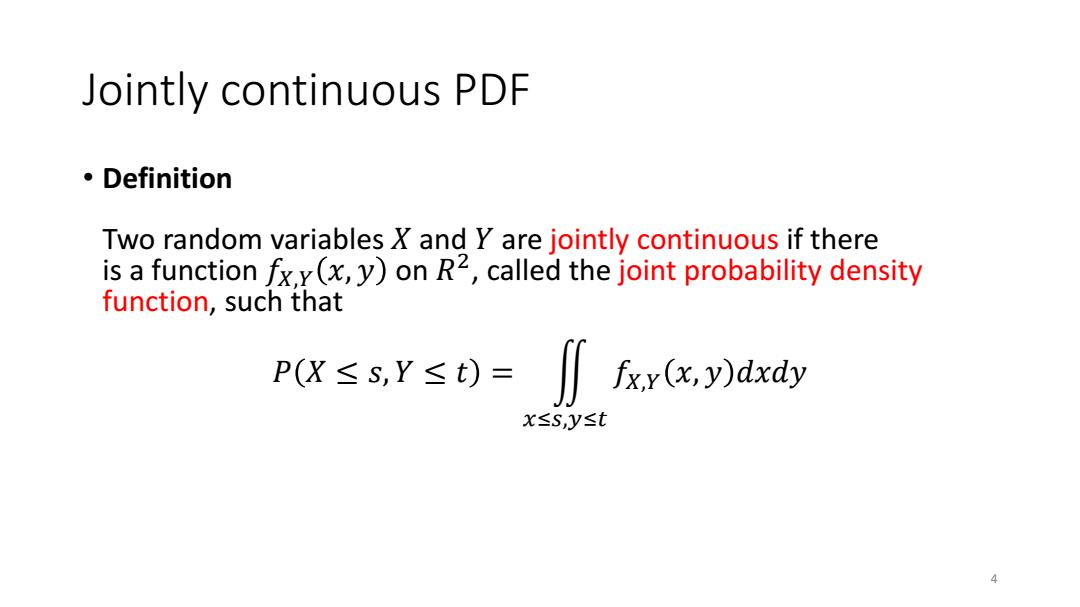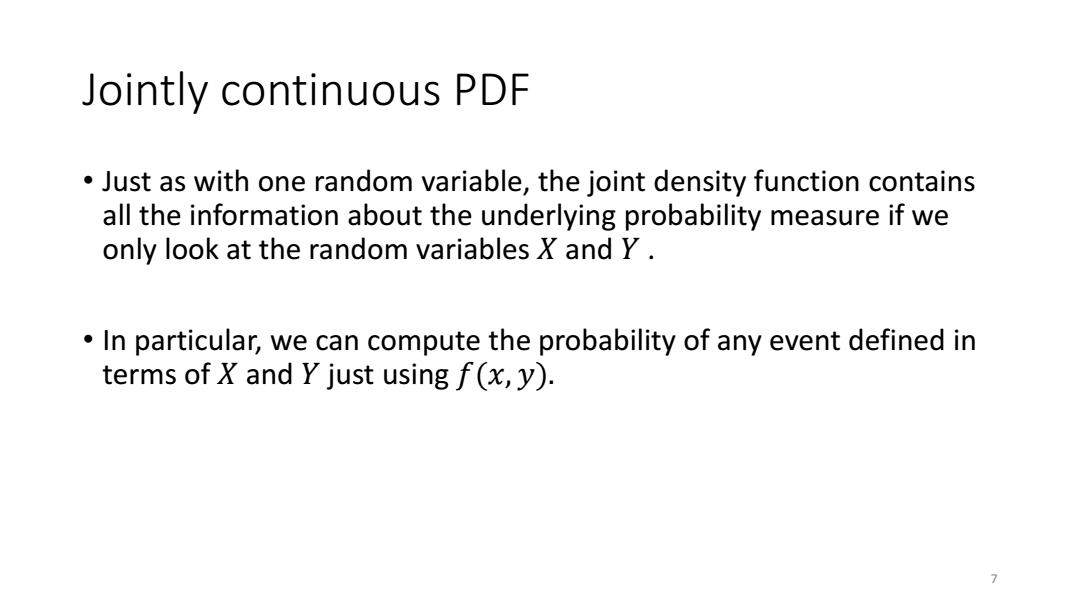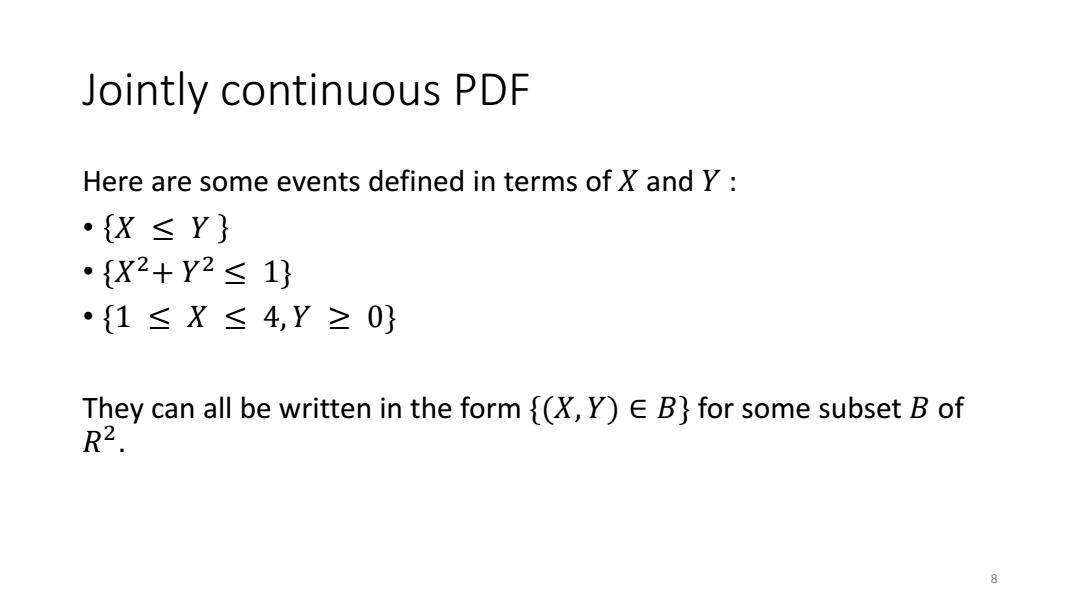
Tutorial 6:General Random Variables 2 Yitong Meng March 6,2016 1
Tutorial 6: General Random Variables 2 Yitong Meng March 6, 2016 1

Outline Extend the notion of PDF to the case of multiple random variables Jointly continuous PDF ·Marginal PDF ·Conditional PDF 。Exercises 2
Outline Extend the notion of PDF to the case of multiple random variables • Jointly continuous PDF • Marginal PDF • Conditional PDF • Exercises 2

Continuous PDF Recall that X is continuous if there is a function f(x)(the density) such that P(X≤t)=fx()dx We generalize this to two random variables. 3
Continuous PDF • Recall that 𝑋 is continuous if there is a function 𝑓(𝑥) (the density) such that 𝑃(𝑋 ≤ 𝑡) = 𝑓𝑋 𝑥 𝑑𝑥 𝑡 −∞ We generalize this to two random variables. 3

Jointly continuous PDF ·Definition Two random variables X and Y are jointly continuous if there is a function fx,y(x,y)on R-,called the joint probability density function,such that PX≤s,Y≤t)= fx.y(x,y)dxdy x≤S,Jy≤t 4
Jointly continuous PDF • Definition Two random variables 𝑋 and 𝑌 are jointly continuous if there is a function 𝑓𝑋,𝑌 𝑥, 𝑦 on 𝑅 2 , called the joint probability density function, such that 𝑃 𝑋 ≤ 𝑠, 𝑌 ≤ 𝑡 = 𝑓𝑋,𝑌 𝑥, 𝑦 𝑑𝑥𝑑𝑦 𝑥≤𝑠,𝑦≤𝑡 4

Jointly continuous PDF ·The integral is over{(x,y):x≤s,y≤t}.We can also write the integral as pPx≤s,Ys0=(r(xawx =("fr.ydx)西 5
Jointly continuous PDF • The integral is over {(𝑥, 𝑦) ∶ 𝑥 ≤ 𝑠, 𝑦 ≤ 𝑡}. We can also write the integral as 𝑃 𝑋 ≤ 𝑠, 𝑌 ≤ 𝑡 = 𝑓𝑋,𝑌 𝑥, 𝑦 𝑑𝑦 𝑡 −∞ 𝑑𝑥 𝑠 −∞ = 𝑓𝑋,𝑌 𝑥, 𝑦 𝑑𝑥 𝑠 −∞ 𝑑𝑦 𝑡 −∞ 5

Jointly continuous PDF In order for a function f(x,y)to be a joint density it must satisfy f(x,y)≥0 fir(x.y)dxdy =1 6
Jointly continuous PDF • In order for a function 𝑓(𝑥, 𝑦) to be a joint density it must satisfy 𝑓(𝑥, 𝑦) ≥ 0 𝑓𝑋,𝑌 𝑥, 𝑦 𝑑𝑥 ∞ −∞ 𝑑𝑦 ∞ −∞ = 1 6

Jointly continuous PDF Just as with one random variable,the joint density function contains all the information about the underlying probability measure if we only look at the random variables X and Y. In particular,we can compute the probability of any event defined in terms of X and Y just using f(x,y). 7
Jointly continuous PDF • Just as with one random variable, the joint density function contains all the information about the underlying probability measure if we only look at the random variables 𝑋 and 𝑌 . • In particular, we can compute the probability of any event defined in terms of 𝑋 and 𝑌 just using 𝑓(𝑥, 𝑦). 7

Jointly continuous PDF Here are some events defined in terms of X and Y: ·X≤Y ·{X2+Y2≤1} ·{1≤X≤4,Y≥0 They can all be written in the form {(X,Y)E B}for some subset B of R2. 8
Jointly continuous PDF Here are some events defined in terms of 𝑋 and 𝑌 : • 𝑋 ≤ 𝑌 • {𝑋 2+ 𝑌 2 ≤ 1} • {1 ≤ 𝑋 ≤ 4, 𝑌 ≥ 0} They can all be written in the form {(𝑋, 𝑌) ∈ 𝐵} for some subset 𝐵 of 𝑅 2 . 8

Jointly continuous PDF Proposition.For B C R2, P(,)eB)=∬ fx.y(x,y)dxdy (x,y)EB The two-dimensional integral is over the subset B of R2 9
Jointly continuous PDF • Proposition. 𝐹𝑜𝑟 𝐵 ⊂ 𝑅 2 , 𝑃 𝑋, 𝑌 ∈ 𝐵 = 𝑓𝑋,𝑌 𝑥, 𝑦 𝑑𝑥𝑑𝑦 (𝑥,𝑦)∈𝐵 The two-dimensional integral is over the subset B of 𝑅 2 9

Jointly continuous PDF Typically,when we want to actually compute this integral 0.4 we have to write it as an 0.2 iterated integral. 0 -5 5 It is a good idea to draw a 0 0 picture of B to help do this. 5-5 Many sample observations are shown from a joint probability distribution.The marginal densities are shown as well. 10
Jointly continuous PDF • Typically, when we want to actually compute this integral we have to write it as an iterated integral. • It is a good idea to draw a picture of 𝐵 to help do this. 10 Many sample observations are shown from a joint probability distribution. The marginal densities are shown as well